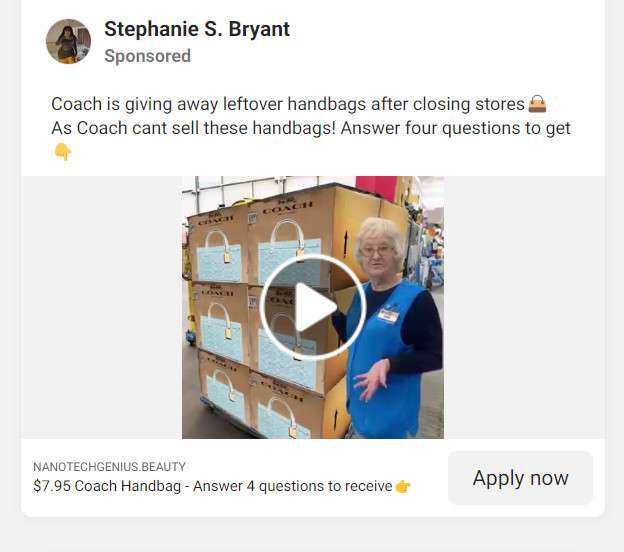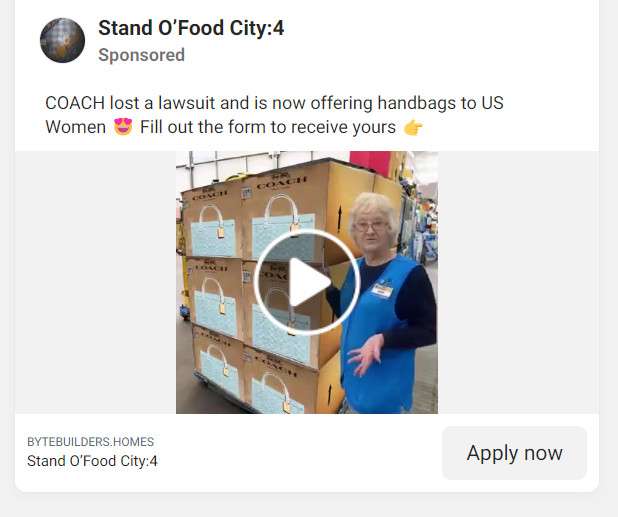Could those tempting social media ads for free Coach handbags be concealing a crafty con? Don’t let the promise of effortless designer deals cause you to drop your guard – fabulous promotions can hide sinister scams.
Before grabbing your credit card, let’s inspect what’s really inside these viral bag giveaways being dangled in front of fashionistas. We’ll break down the clever mechanisms exploiting shoppers’ lust for luxury logos and uncover how to sidestep these snares.
It’s time to outsmart schemers hoping to line their pockets through your love of labels. We can secure our data, halt recurring hidden fees, and spread the word to other consumers.

This Article Contains:
Scam Overview: Dissecting the Elaborate Coach Handbag Cons Targeting Eager Shoppers
This scam leverages Coach’s coveted brand cachet and wide store availability to promote fictional free handbag giveaways on social platforms. It starts with enticing sponsored posts boasting authentic Coach branding and images of popular purses like the Signature, Cassie and Tabby styles.
The compelling social media ads claim Coach is generously providing their latest handbag prototypes to female customers for free product testing and feedback before full market release.
The scam ads cite various fabricated reasons for the imaginary promotion including clearing out excess inventory, anniversary events, or packaging redesign tests with major retailers. However, there are absolutely zero free Coach handbags being given away regardless of the phony backstory provided in the ads.
The advertised quantities of free handbags also range widely between different versions of the scam, from a couple hundred available to thousands ready for claiming. But these inventory numbers are completely made up – no actual Coach handbags exist to ship out to testers.
Some scam ads utilize convincing AI-generated voices or deepfake celebrity endorsements announcing the fictional giveaways and product tester opportunities. This aims to add credibility to the ruse and trick shoppers into believing the promotions are real. But it’s just synthetic promotion for a deal that doesn’t actually exist.
The social media ads drive urgency, prompting users to click through quickly before the imaginary opportunity disappears forever. This capitalizes on shoppers’ eagerness to claim high-value Coach merchandise for free.

Clicking the call-to-action links redirects victims to elaborate fake portal websites dressed up to mirror Nordstrom, Costco, Walmart or other major retailers’ real online presence. Here users can supposedly sign up to claim their mythic free Coach tester handbag.
The fraudulent sites display precise branding, logos, fonts, colors and photos to appear completely authentic. Visitors asked to provide personal details to register for the fictional promotion. After answering basic questions, people see a congratulatory message about “winning” a handbag that will never ship.
Next, the fake sites request credit card information, often citing a small $1 “shipping fee” for the imaginary free handbag. However, shady fine print buries terms allowing recurring monthly billing to submitted cards. While the $1 seems trivial, it enables endless billing access for scammers.
By revealing the calculated scam mechanisms, we can recognize these fake promotions for what they really are – an intricate ruse to dishonestly obtain users’ financial and personal data. Verify special handbag deals directly through official retailer and Coach channels only before providing information.
This scam has been also investigated by Jordan Liles on his YouTube channel, where he offers a detailed video on the subject. We recommend watching his content for a comprehensive understanding of the scam.
Next, let’s break down exactly how scammers carry out this scam from start to finish.
An In-Depth Explanation of How the Viral Coach Handbag Scam Cons Online Shoppers
This scam preys on shoppers’ desire to score prestige Coach purses for free. Here’s how it typically unfolds:
Step 1: Posting Eye-Catching Social Media Ads
The fraudsters create sponsored Facebook, Instagram and Youtube ads featuring real Coach branding and handbag visuals. The compelling copy drives demand by advertising free bags for female customers only.
Step 2: Driving Traffic to Elaborate Fake Sites
The social ads urge viewers to click through immediately before the fictional opportunity disappears. The links send victims to phony websites dressed up to mimic Coach’s real online stores.
Step 3: Harvesting Personal Information
On the fake sites, visitors must complete a short “registration” with personal details to claim their fictitious free bag. This data harvesting adds legitimacy while gathering data like names, addresses, phone numbers and emails.
Step 4: Obtaining Credit Card Information
After registering, people are congratulated for “winning” a handbag that doesn’t exist. The fraudulent site then requests their credit card info, often claiming it is only to cover a small $1 shipping fee. But this grants the scammers recurring billing access.
Step 5: Charging Hidden Monthly Fees
With the credit card data stolen, scammers start auto-billing inflated monthly subscription fees outlined in obscure fine print terms. When surprise fees stack up but no bag arrives, the scam becomes clear.
Step 6: No Free Coach Handbags Ship Out
Eventually users realize no free Coach purse will ship out since the entire promotion was fake. The phony giveaway simply allowed scammers to illegally obtain users’ financial and personal information through manipulation.
Avoid engaging with these viral handbag cons on social platforms. Verify special promotions only through official Coach channels and think critically before providing data. Now let’s explore how to limit damages if you took the bait on one of these bag scams.
How to Identify This Viral Handbag Promotion Scam
Apply healthy skepticism when you see social media posts, videos or ads touting an unbelievable Coach handbag giveaway through major retailers. Watch for these common scam indicators:
- Eye-catching ads boasting of a special deal between Coach and stores like Nordstrom, Walmart, Costco to give away free bags. Often cites excess inventory as the reason.
- Creates false urgency, telling you to click through right away before the fictional limited-time promotion disappears.
- Redirects clickers to fake retailer websites that mimic real branding but are unaffiliated imposter sites.
- The scam portal claims to be the official Coach offer registration site tied to the major retailer.
- Asks for personal data like name, address, email, phone to register you for the imaginary promotion.
- Specifically requests credit card information, frequently citing a small $1 “shipping fee” you must pay.
- Fine print or pre-checked boxes secretly signing you up for recurring monthly plans you didn’t approve.
- Example: “Excusive Coach & Nordstrom Giveaway! Coach is giving away free handbags for their anniversary. Click here and claim yours now before they’re gone!”
Any remarkable social media bag deal with these scam markers should be avoided entirely. Verify real Coach promotions through official retailer and brand channels before providing data or payment access. Report suspicious ads ASAP.
What To Do If You Already Got Hooked by the Coach Handbag Scam
If you provided your information or credit card data to one of these fictional Coach handbag promotions, take these steps right away to protect yourself:
- Contact your credit card company ASAP to report fraudulent charges. Cancel and reissue your card to stop billing.
- Monitor statements vigilantly for any unauthorized subscription fees and swiftly dispute them.
- Change passwords on any accounts you accessed through scam links as a security precaution.
- Freeze credit if identity theft is a concern, preventing scammers from opening new lines of credit.
- Document details about the scam and report it to the FTC, IC3, social networks, Coach, and local law enforcement.
- Warn other consumers online about current bag cons to prevent more victims.
- Learn to scrutinize remarkable free product offers and always go directly to official brand sites first before providing payment info.
Take action quickly if this scam hooked you, but know that reporting fraud helps limit damages. Carefully assess promotions for free high-dollar products to dodge traps. Let’s recap the key lessons this handbag scam teaches about critical thinking and online safety.
FAQs: Avoiding the Fake Coach Bag Promotions on Social Media
1. How does the phony Coach handbag giveaway scam operate?
These scams start with social ads for free Coach bags. Clicking links goes to fake sites stealing your data and card for monthly fees, not free bags.
2. What are red flags of this Coach handbag scam?
Watch for too-good-to-be-true deals, high-pressure limited-time claims, unnecessary credit card requests for $1 “shipping”, and shady terms enabling recurring billing you didn’t approve.
3. What should I do if I entered my card already?
Contact your credit card company ASAP to report fraudulent charges. Cancel and reissue your card to halt billing. Monitor statements for unauthorized subscription fees to dispute.
4. How can I avoid handbag cons in the future?
Be skeptical of remarkable free product offers and always directly verify promotions through official Coach channels first before providing any personal or payment data.
5. How do I report these fake Coach ads?
Report scam ads immediately to Coach, FTC, IC3, social networks and local authorities. Share scam warnings online to prevent more victims. Seek takedown of fraudulent accounts spreading cons.
6. Who creates these fake Coach ads?
These ads are made by unknown scammers aiming to illegally collect users’ financial and personal information. Responsible platforms work to remove prohibited scam content.
7. Why are handbags targeted?
Scammers know Coach bags are coveted high-price items. By promoting unbelievable free deals, these cons exploit shoppers’ desire for expensive merchandise.
8. Are there other fake product giveaway scams?
Yes, variations also tout remarkable free deals for sunglasses, headphones, jewelry, clothing, shoes, makeup, phones, and more. Apply the same critical thinking for any too-good-to-be-true offers.
9. Who often falls victim to these scams?
Deal-seekers eager for free products are common targets. But vigilance protects anyone from getting conned. Never provide payment access without confirming directly with real brand sites first.
10. What should I do if I see a sketchy handbag ad?
If an ad touts implausible free bag deals, avoid engaging and report it immediately to protect other consumers from the scam. Promote awareness to stop the fraudsters.
The Bottom Line: Verify Unbelievable Luxury Product Giveaways Targeting Shoppers
This Coach handbag scam provides a sobering reminder to carefully evaluate remarkable social media promotions offering coveted designer merchandise for free. Scammers know such enticing baits attract clicks and data entry.
But we can outsmart their traps by thinking critically, validating offers directly with official brand channels, and never providing payment information without confirming legitimacy first. While staying vigilant takes work, it’s crucial to avoid having our fashion desires manipulated.
Don’t let cons capitalize on your affinity for designer deals – actively protect your data and accounts instead. Apply sound skepticism to keep personal and financial information far from the grasp of fraudsters. Recognize unbelievable luxury freebies as lures concealing devious scams.










